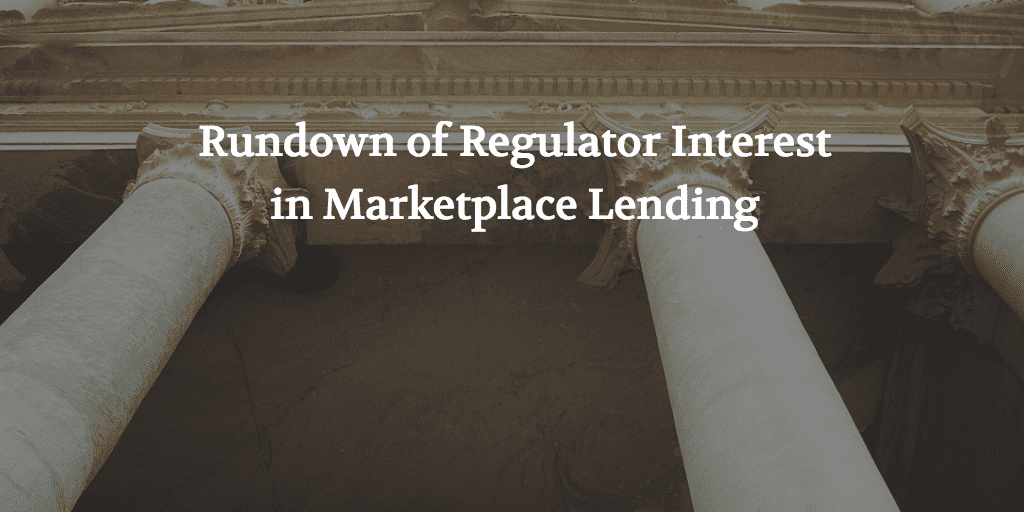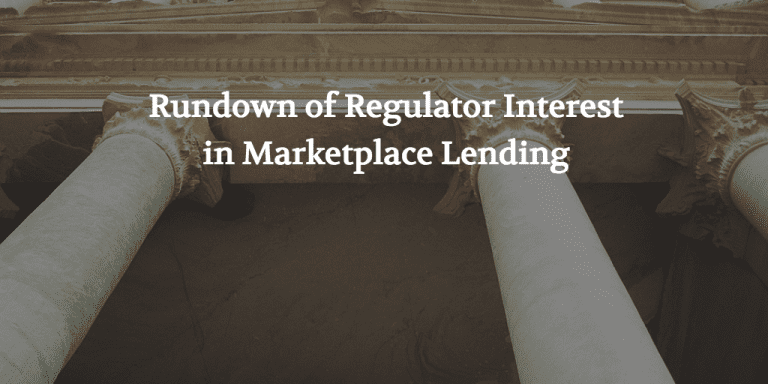
Since the marketplace lending industry began, it has always been inevitable that at some point regulators would take an increased interest in the industry. Not because the industry isn’t currently regulated, but because it is beginning to reach more individuals and serve them in a new and different way. Over the last year we have seen increased interest in regulation related to marketplace lending and it spans several different government organizations. We’ve also seen several new industry associations formed. In this post, we’ll highlight the many government organizations and how they have expressed their interest in marketplace lending.
U.S. Treasury
The Treasury first publicly showed interest in marketplace lending with a request for information (RFI) back in July 2015. Over 100 companies responded to the RFI and the Treasury reported on their findings in May 2016 where they shared their response in the form of a white paper. This excellent white paper highlighted key themes from those who responded and also suggestions on what the industry can do going forward. Interestingly, it did not provide any recommendations for new regulations and was generally quite positive on the industry. The white paper also called for the creation of a working group that would include many of the agencies in this post.
Office of Comptroller of the Currency (OCC)
On March 31, the OCC released a white paper titled Supporting Responsible Innovation in the Federal Banking System: An OCC Perspective. Although the white paper was focused on fintech broadly, a discussion of marketplace lending was included. Various questions were posed as a request for comments and Lending Club was one of many companies to respond.
More recently, the head of the OCC, Thomas Curry, reaffirmed his commitment to responsible innovation in a speech just last week. He brought up the idea of a “regulatory sandbox” – a place where fintech companies can have a conversation about what the rules of the road are for their new ideas. He also brought up the idea of a limited purpose charter for fintech firms as a possible way forward.
Federal Deposit Insurance Corporation (FDIC)
The FDIC first addressed marketplace lending in a paper titled Supervisory Insights. In it, they provide an overview of the marketplace lending business model and associated risks although it didn’t really change any of the existing rules. In November of 2015 we also heard FDIC Chairman Gruenberg state they were watching the explosive growth of marketplace lending. They are concerned about the impact on banks as well as the general risk to financial services.
Consumer Financial Protection Bureau (CFPB)
Early this year, the CFPB made two announcements impacting marketplace lending. They said that they would begin accepting complaints directly from consumers about marketplace lending companies. Around the same time they issued a new No-Action letter policy that was designed to encourage innovation in financial services.
According to the Wall Street Journal the CFPB is planning to supervise marketplace lenders and will release a proposal some time in the fall. The CFPB has not commented publicly on this news so right now it is just a possibility but it makes sense.
Securities and Exchange Commission (SEC)
SEC involvement in marketplace lending goes back to the early days of Lending Club and Prosper. In 2008 the SEC decided that the notes issued by these companies were securities and should be registered as such. The result was Lending Club and Prosper filing a S-1 registration and becoming quasi public companies with quarterly financials being filed with the SEC.
Now that Lending Club is a public company it is has more responsibilities to both equity and debt investors both of which come under the purview of the SEC. The reality is while the SEC keeps a close eye on marketplace lending it is unlikely there will be much in the way of new developments here.
Federal Trade Commission (FTC)
The FTC recently hosted a financial technology forum on marketplace lending that included Peter Renton, the founder of Lend Academy. The forum sought to look at consumer protections in marketplace lending and fintech more broadly. According to Jessica Rich, director of the FTC’s consumer-protection bureau marketplace lenders haven’t done enough in borrower protection. She stated:
To be meaningful, these types of efforts need robust procedures to monitor compliance and tangible consequences when the rules aren’t followed. Otherwise, you can’t be sure that companies have the incentive to comply, or are complying. And again, the standards aren’t meaningful if that’s the case.
The various industry associations aim to calm some concerns of borrower protection by having strict requirements around pricing, fees etc. but it’s clear regulators do not believe self regulation is enough.
United States Congress
In May 2015, the House Small Business Committee held a hearing on Capital Hill. Peter Renton and several others including Funding Circle Co-Founder Sam Hodges shared their thoughts to help educate congress on small business marketplace lenders. Much of the concerns of the members centered around current regulation and borrower protections. A borrower who was also invited to speak touted just how beneficial one marketplace lender was in securing financing he desperately needed for his growing business.
In January, in the wake of the San Bernardino shooting tragedy, the House Financial Services Committee held a hearing on terrorism financing that included a discussion of marketplace lending. But no new initiatives have come yet from these hearings. More recently U.S. Representative Patrick McHenry, a North Carolina Republican and vice-chairman of the House Financial Services Committee, has drafted a letter to the Government Accountability Office calling for more study of the benefits of fintech startups.
Financial Stability Oversight Council (FSOC)
The FSOC most recently included their thoughts on marketplace lending in their annual report. Although the report highlights the lower cost and efficiencies of marketplace lenders they also discuss risks and concerns. One of the main concerns listed are the new and untested underwriting models used by platforms. The report also discussed lack of a robust secondary market as well as the fact that some marketplace lenders do not have skin in the game since they do not hold loans on their balance sheet. They note that regulators need to be vigilant in monitoring the growing industry of marketplace lending despite the small current penetration of marketplace lending.
Conclusion
This list is only a start of the involvement we are likely to see from regulators as it pertains to marketplace lending. Due to the attention, we’ve seen many industry associations created to ensure a productive dialogue is being undertaken in Washington with all the organizations discussed here. We sincerely hope that any new regulation to come is thoughtful and comes from a well informed view of the industry.


